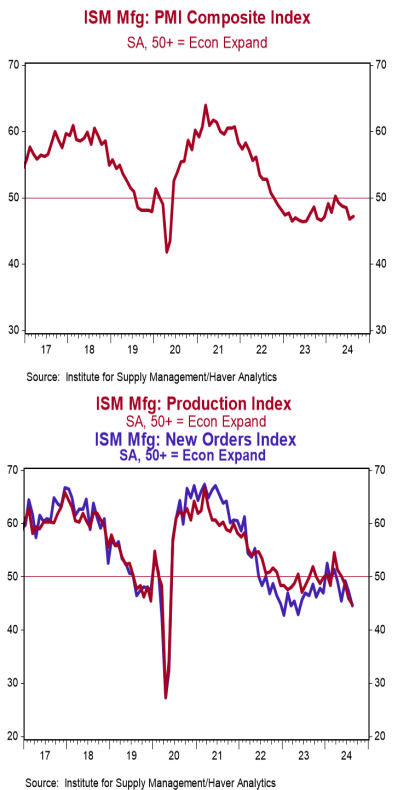- The ISM Manufacturing Index increased to 47.2 in August, lagging the consensus expected 47.5. (Levels higher than 50 signal expansion; levels below 50 signal contraction.)
- The major measures of activity were mixed in August. The new order index declined to 44.6 from 47.4, while the production index dropped to 44.8 from 45.9. The employment index rose to 46.0 from 43.4 in July, while the supplier deliveries index fell to 50.5 from 52.6.
- The prices paid index rose to 54.0 in August from 52.9 in July.
Implications: The ISM Manufacturing index missed consensus expectations once again in August and the details of the report are worrisome. Activity in the manufacturing sector has now contracted for twenty-one out of the last twenty-two months. Overall, twelve of the eighteen major manufacturing industries reported contraction in August while five reported growth and one reported no change. Despite an increase in the overall index, the two most important parts of the report – demand and output – both worsened in August. Looking at the details, the new orders index dropped to 44.6, the lowest level since May 2023, marking the twenty-second month in the last two years where the index has been below 50. Manufacturing companies have been able to scrape by despite weak demand by focusing on their order backlogs, which were artificially boosted with pent-up activity from the COVID years. That index, which remained deep in contraction territory at 43.6, has been below 50 for twenty-three consecutive months. However, it looks like this reprieve for weaker demand may be coming to an end as the production index fell to the lowest level since the COVID lockdown months at 44.8. Survey comments from manufacturing companies have noted dwindling backlogs, which are prompting them to take cost actions. This can be clearly seen in the employment index, which remains near the lowest level since the COVID lockdown months at 46.0. Of the eighteen major manufacturing industries, just three reported an increase in employment, while ten reported a decline. The weakness in the ISM Manufacturing index underpins a growing list of economic data pointing to a slowdown in growth. We expect to see continued manufacturing weakness in the second half of 2024 as the bill for reckless and artificial spending by our government from the COVID years comes due and the lagged impacts from the drop in the M2 measure of the money supply from early 2022 through late 2023 take effect. In other news this morning, construction spending declined 0.3% in July, led by large drops in homebuilding and health care projects.





